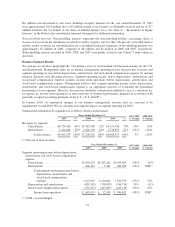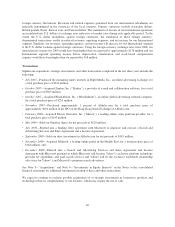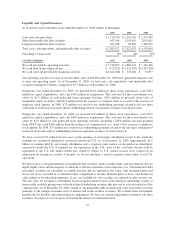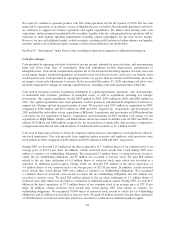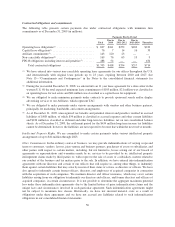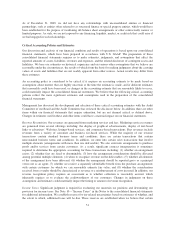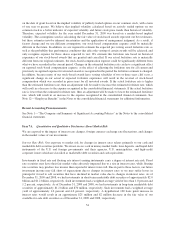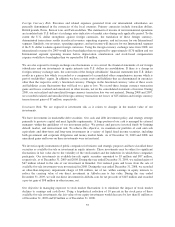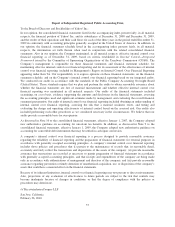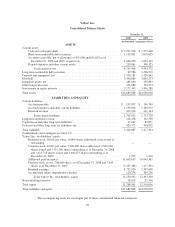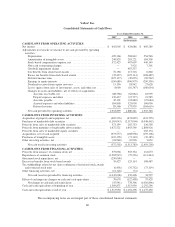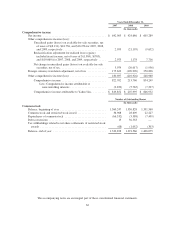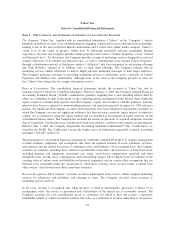Yahoo 2009 Annual Report Download - page 61
Download and view the complete annual report
Please find page 61 of the 2009 Yahoo annual report below. You can navigate through the pages in the report by either clicking on the pages listed below, or by using the keyword search tool below to find specific information within the annual report.•Discount rates
We employ a Weighted Average Cost of Capital (“WACC”) approach to determine the discount rates used in
our cash flow projections. The determination of the discount rates for each reporting unit includes factors such
as the risk-free rate of return and the return an outside investor would expect to earn based on the overall level
of inherent risk. The determination of expected returns includes consideration of the beta (a measure of risk) of
traded securities of comparable companies.
The sum of the fair values of our reporting units is reconciled to our market capitalization adjusted for an
estimated control premium.
We conducted our annual goodwill impairment test as of October 31, 2009 and determined that the fair values of
our reporting units exceeded their carrying values by a significant margin and therefore goodwill in those
reporting units was not impaired.
Significant changes in these estimates and assumptions could materially affect the determination of fair value for
each reporting unit which could trigger future impairment.
Intangible Assets. We amortize intangible assets over their estimated useful lives. Identifiable amortizable
intangible assets are reviewed for impairment whenever events or changes in circumstances indicate that the
carrying value may not be recoverable. Determination of recoverability is based on the lowest level of
identifiable estimated undiscounted future cash flows resulting from use of the asset and its eventual disposition.
Measurement of any impairment loss is based on the excess of the carrying value of the asset over its fair value.
Fair value is determined based on the lowest level of identifiable estimated future cash flows using discount rates
determined by our management to be commensurate with the risk inherent in our business model. Our estimates
of future cash flows attributable to our intangible assets require significant judgment based on our historical and
anticipated results and are subject to many factors. Different assumptions and judgments could materially affect
estimated future cash flows relating to our intangible assets which could trigger impairment. No impairments of
intangible assets were identified during any of the periods presented.
Investments in Equity Interests. We account for investments in the common stock of entities in which we have
the ability to exercise significant influence but do not own a majority equity interest or otherwise control using
the equity method. In accounting for these investments we record our proportionate share of the entities’ net
income or loss, one quarter in arrears.
We review our investments in equity interests for impairment whenever events or changes in business
circumstances indicate that the carrying value of the investment may not be fully recoverable. Investments
identified as having an indication of impairment are subject to further analysis to determine if the impairment is
other-than-temporary and this analysis requires estimating the fair value of the investment. The determination of
fair value of the investment involves considering factors such as the stock prices of public companies in which
we have an equity investment, current economic and market conditions, the operating performance of the
companies, including current earnings trends and forecasted cash flows, and other company and industry specific
information. The fair value determination, particularly for investments in privately-held companies, requires
significant judgment to determine appropriate estimates and assumptions. Changes in these estimates and
assumptions could affect the calculation of the fair value of the investments and the determination of whether any
identified impairment is other-than-temporary.
Stock-Based Compensation Expense. We recognize stock-based compensation expense net of an estimated
forfeiture rate and therefore only recognize compensation expense for those shares expected to vest over the
service period of the award. Calculating stock-based compensation expense requires the input of highly
subjective assumptions, including the expected term of the stock-based options, stock price volatility, and the
pre-vesting award forfeiture rate. We estimate the expected life of options granted based on historical exercise
patterns, which we believe are representative of future behavior. We estimate the volatility of our common stock
53



